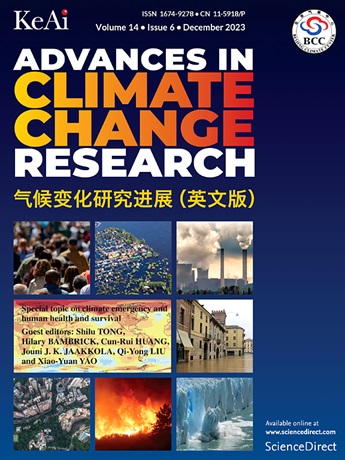人类活动和低频气候变率对世纪尺度东亚气温变化的影响
IF 5.2
1区 地球科学
Q1 ENVIRONMENTAL SCIENCES
引用次数: 0
摘要
东亚是世界上人口最稠密的地区之一。了解人类造成温度变化的原因,特别是在世纪尺度上,对适应和减缓气候变化非常重要。然而,由于早期历史时期的观测资料有限,极端温度的归因研究仍然不足。本文利用耦合模式比对项目第6阶段的多期观测资料和模拟,研究了1901-2020年海面温度的外部强迫和低频气候变率对日最高(Tmax)、最低温度(Tmin)及其差(日温度差,DTR)变化的影响。东亚地区的增温趋势存在季节差异,春季和冬季的增温幅度大于其他两个季节。基于最优指纹法的检测和归因结果表明,1901-2020年,人为强迫主要解释了观测到的Tmax和Tmin变化。温室气体强迫对年Tmax和Tmin变化的贡献约为1.1°C(90%置信区间(CI): 0.78-1.3°C)和1.4°C(90%置信区间(CI): 1.19-1.58°C),而人为气溶胶强迫抵消了0.47°C(90%置信区间:0.15-0.92°C)和0.4°C(90%置信区间:0.07-0.77°C)的变暖。对于DTR,由于信噪比小,无法检测到人为信号。同时,来自大西洋多年代际涛动的低频气候变率的影响较小,主要归因于全球变化引起的大西洋变暖。这些归因信息加强了科学依据,有助于决策者制定有效的策略和计划。本文章由计算机程序翻译,如有差异,请以英文原文为准。
Effects of human activities and low-frequency climate variability on East Asian temperature changes at century scale
East Asia is one of the most densely populated regions in the world. Understanding the human causes of temperature changes, especially at the century scale, is important for climate change adaptation and mitigation. However, the attribution study of extreme temperature remains inadequate because of limited observational data from early historical periods. Here, we utilise multiple observational data and simulations from the Coupled Model Intercomparison Project Phase 6 to investigate the influence of external forcing and low-frequency climate variability from sea surface temperature on the changes in daily maximum (Tmax), minimum temperature (Tmin) and their difference (diurnal temperature range, DTR) during the period of 1901–2020. We find that the warming trends in East Asia differ across seasons, with the warming magnitudes in spring and winter greater than those in the other two seasons. Detection and attribution based on an optimal fingerprinting method show that anthropogenic forcing mainly explains the observed changes in Tmax and Tmin during 1901–2020. Greenhouse gas forcing contributes approximately 1.1 °C (90% confidence intervals (CI): 0.78–1.3 °C) and 1.4 °C (90% CI: 1.19–1.58 °C) of annual Tmax and Tmin changes, while the anthropogenic aerosol forcing offsets 0.47 °C (90% CI: 0.15–0.92 °C) and 0.4 °C (90% CI: 0.07–0.77 °C) of the warming. For the DTR, the anthropogenic signal could not be detected due to the small signal-to-noise ratio. Meanwhile, the effects of the low-frequency climate variability coming from the Atlantic Multidecadal Oscillation are small and mainly attributed to the warming of the Atlantic Ocean induced by global change. This attribution information strengthens the scientific basis and helps decision-makers develop effective strategies and plans.
求助全文
通过发布文献求助,成功后即可免费获取论文全文。
去求助
来源期刊

Advances in Climate Change Research
Earth and Planetary Sciences-Atmospheric Science
CiteScore
9.80
自引率
4.10%
发文量
424
审稿时长
107 days
期刊介绍:
Advances in Climate Change Research publishes scientific research and analyses on climate change and the interactions of climate change with society. This journal encompasses basic science and economic, social, and policy research, including studies on mitigation and adaptation to climate change.
Advances in Climate Change Research attempts to promote research in climate change and provide an impetus for the application of research achievements in numerous aspects, such as socioeconomic sustainable development, responses to the adaptation and mitigation of climate change, diplomatic negotiations of climate and environment policies, and the protection and exploitation of natural resources.
 求助内容:
求助内容: 应助结果提醒方式:
应助结果提醒方式:


